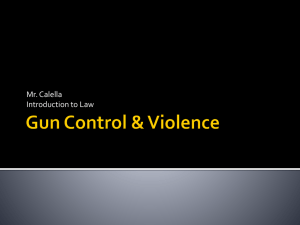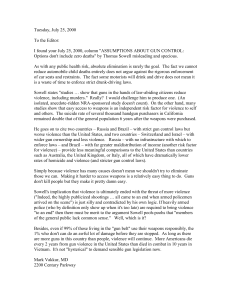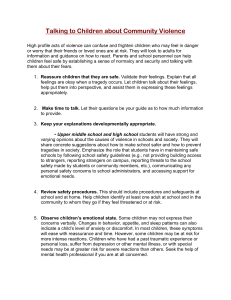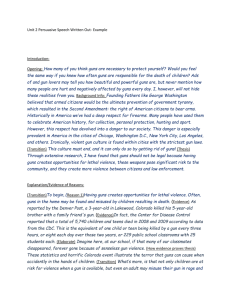Guns and Violence Against Women
advertisement
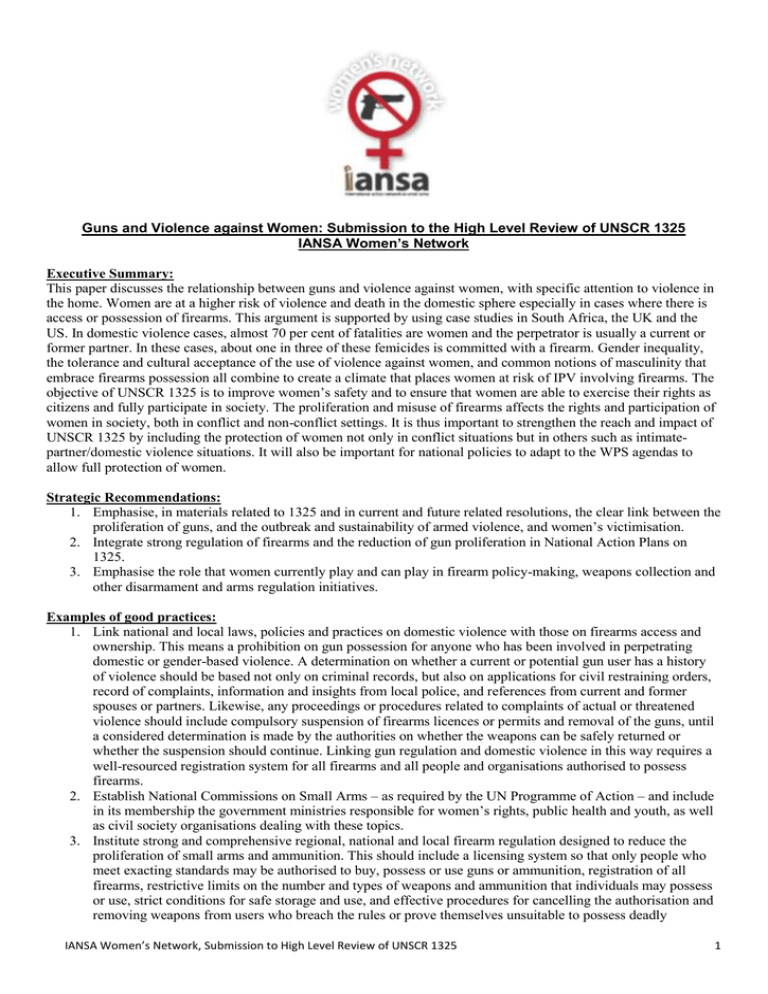
Guns and Violence against Women: Submission to the High Level Review of UNSCR 1325 IANSA Women’s Network Executive Summary: This paper discusses the relationship between guns and violence against women, with specific attention to violence in the home. Women are at a higher risk of violence and death in the domestic sphere especially in cases where there is access or possession of firearms. This argument is supported by using case studies in South Africa, the UK and the US. In domestic violence cases, almost 70 per cent of fatalities are women and the perpetrator is usually a current or former partner. In these cases, about one in three of these femicides is committed with a firearm. Gender inequality, the tolerance and cultural acceptance of the use of violence against women, and common notions of masculinity that embrace firearms possession all combine to create a climate that places women at risk of IPV involving firearms. The objective of UNSCR 1325 is to improve women’s safety and to ensure that women are able to exercise their rights as citizens and fully participate in society. The proliferation and misuse of firearms affects the rights and participation of women in society, both in conflict and non-conflict settings. It is thus important to strengthen the reach and impact of UNSCR 1325 by including the protection of women not only in conflict situations but in others such as intimatepartner/domestic violence situations. It will also be important for national policies to adapt to the WPS agendas to allow full protection of women. Strategic Recommendations: 1. Emphasise, in materials related to 1325 and in current and future related resolutions, the clear link between the proliferation of guns, and the outbreak and sustainability of armed violence, and women’s victimisation. 2. Integrate strong regulation of firearms and the reduction of gun proliferation in National Action Plans on 1325. 3. Emphasise the role that women currently play and can play in firearm policy-making, weapons collection and other disarmament and arms regulation initiatives. Examples of good practices: 1. Link national and local laws, policies and practices on domestic violence with those on firearms access and ownership. This means a prohibition on gun possession for anyone who has been involved in perpetrating domestic or gender-based violence. A determination on whether a current or potential gun user has a history of violence should be based not only on criminal records, but also on applications for civil restraining orders, record of complaints, information and insights from local police, and references from current and former spouses or partners. Likewise, any proceedings or procedures related to complaints of actual or threatened violence should include compulsory suspension of firearms licences or permits and removal of the guns, until a considered determination is made by the authorities on whether the weapons can be safely returned or whether the suspension should continue. Linking gun regulation and domestic violence in this way requires a well-resourced registration system for all firearms and all people and organisations authorised to possess firearms. 2. Establish National Commissions on Small Arms – as required by the UN Programme of Action – and include in its membership the government ministries responsible for women’s rights, public health and youth, as well as civil society organisations dealing with these topics. 3. Institute strong and comprehensive regional, national and local firearm regulation designed to reduce the proliferation of small arms and ammunition. This should include a licensing system so that only people who meet exacting standards may be authorised to buy, possess or use guns or ammunition, registration of all firearms, restrictive limits on the number and types of weapons and ammunition that individuals may possess or use, strict conditions for safe storage and use, and effective procedures for cancelling the authorisation and removing weapons from users who breach the rules or prove themselves unsuitable to possess deadly IANSA Women’s Network, Submission to High Level Review of UNSCR 1325 1 weapons. The regulatory scheme should require implementation of the International Tracing Instrument on small arms and the establishment and operation of adequately resourced units for tracing firearms and investigating arms trafficking. Snapshot: Guns Make Intimate Partner Violence More Deadly Domestic violence assaults involving a gun are 12 times more likely to result in death than those involving other weapons or bodily force1. While men are mostly killed by someone they may not know, almost half of all female victims are killed by those closest to them. Almost 15 per cent of all homicides stem from domestic violence (63,600)2. However, the overwhelming majority - almost 70 per cent - of domestic violence fatalities are women (43,600)3. Globally, around half of all homicides are committed with firearms (UNODC, 2011) Research reveals wide regional variations, with guns used in 74 per cent of all homicides in the Americas compared to 21 per cent in Europe, where gun ownership levels are relatively low (UNODC, 2011) In Asia, Europe and Oceania the share of victims from domestic violence is particularly important. In all these regions, the majority of female homicide victims are killed at the hands of their intimate partners/family members (in Asia and Europe, 55 per cent, and in Oceania, 73 per cent). For example, in Asia, 19,700 women were killed by their intimate partners or family members in 2012. When only looking at intimate partner violence, the overwhelming majority of homicide victims are women (79 per cent in Europe)4. In France, which has 30 guns per 100 people, 33% of women killed by their partners are shot. In the US, which has 96 guns per 100 people, this percentage rises to 66%. In South Africa, a woman is shot dead by her current or former partner every six hours. Small Arms Survey Findings 2013: Homicide data provides particularly strong evidence of the gendered nature of IPV, showing that ‘almost without exception [. . .] females are at greater risk than males, and that the majority of female homicide victims are killed by male intimate partners’ (UNGA, 2012) In a recent analysis of femicides worldwide, the Geneva Declaration on Armed Violence and Development investigates some of these gender differences. Based on data for 111 countries and territories, the study finds that around 66,000 women are killed violently each year around the world, representing some 17 per cent of all intentional homicides. These femicides generally occur in the domestic sphere, and the perpetrator is usually a current or former partner. About one in three of these femicides is committed with a firearm. (Alvazzi del Frate, 2011) Firearms also play a significant role in non-fatal injury, threats, and intimidation by intimate partners, all of which are widespread and highly gendered. Whereas some men display or brandish weapons to threaten their female partners, the reverse is rare (Johnson and Dawson, 2011). A recent body of research identifies a range of types of intimate partner violence and threats, including with firearms; this behaviour forms part of a pattern of ‘coercive controlling violence’, which is characteristically used by men against their female partners (Ansara and Hindin, 2010). In countries with high levels of firearm violence, the risk that IPV against women will involve firearms is higher than elsewhere. Based on the Global Burden of Armed Violence database, some 25 countries in southern Africa and Latin America and the Caribbean show ‘high’ or ‘very high’ rates of homicide and femicide compared to others. In those countries, more than 60 per cent of femicides are committed with firearms. 1 Linda E. Saltzman, et al., Weapon Involvement and Injury Outcomes in Family and Intimate Assaults, 267 JAMA, 3043-3047 (1992) ibid 3 ibid 4 http://www.unodc.org/unodc/en/press/releases/2014/April/some-437000-people-murdered-worldwide-in-2012-according-to-new-unodcstudy.html 2 IANSA Women’s Network, Submission to High Level Review of UNSCR 1325 2 In Peru, research shows that 70 per cent of femicides are perpetrated by intimate partners (UNGA, 2012). In 2010, the police recorded a total of 121 femicides and 47 attempted femicides. In 99 per cent of the cases, the aggressor was a man; most perpetrators were partners or ex-partners and 55 per cent of the femicides took place in the home. Ten per cent of the incidents were gun-related, while the most frequently used weapon was a knife or sharp object (Peru, 2010); that rate of firearm-related femicides appears to be much lower than in other countries (Small Arms Survey, 2012). A number of high-income countries, such as Canada and England and Wales, have experienced a decline in intimate partner homicides over the past three decades (Statistics Canada, 2011). A similar decline is evident in the United States, whose Bureau of Justice Statistics shows a drop in the rate of IPV, homicides, and non-fatal injuries between 1980 and 2010, especially as regards male victims (Cooper and Smith, 2011). Yet, despite the decline in intimate partner homicides, the proportion of female IPV victims has remained relatively stable, and four out of every five victims are female (Catalano, 2012). Women are not only predominantly the victims, they are also more likely to be killed or threatened by firearms than men in such circumstances. Canada is a case in point. Even though the rate of spousal homicides has declined over the past 30 years, national data for 2000–09 shows that women are still 3–4 times more likely to be killed by their spouses than are men; in 26 per cent of these cases, women are killed with firearms, compared with 11 per cent of the men (Statistics Canada, 2011). While the majority of the victims and perpetrators of firearms-related homicides are male, many more women than men are killed, injured, and intimidated by firearms in the context of IPV. Intimate partner murder followed by suicide (‘murder–suicide’) is primarily perpetrated by men, and firearms are the predominant weapon. Most gun owners are men, as are the majority of individuals in professions using guns—such as the armed forces, police, or private security; the risk of lethal IPV for women, as well as injury and intimidation, is increased by the presence of guns in the home, including work-related guns. Gender inequality, the tolerance and cultural acceptance of the use of violence against women, and common notions of masculinity that embrace firearms possession (which may be supported by both men and women) all combine to create a climate that places women at risk of IPV involving firearms. Withdrawal of gun rights following IPV incidents and the use of risk assessments for intimate partner homicide may help prevent subsequent violence, but only if cases are reported, which only a small minority are. Promising strategies to reduce gun-related IPV include stricter civilian gun possession regulations, broader prevention policies that raise awareness of the dangers of firearms in intimate partner settings, and interventions to change cultural attitudes to guns in relation to certain concepts of masculinity. Data that disaggregates victim–offender relationships and the type of weapon used in intimate partner violence and homicides is needed to track patterns and trends in firearm use, and to guide interventions and their evaluation. South Africa In 2000 the government introduced a Firearms Control Act, introducing a competency test to restrict gun ownership. But anti-gun groups say that domestic shootings remain an inevitable outcome of allowing gun ownership. For many South Africans having a gun in the home is about protecting them against the stranger intruder but data both in South Africa and elsewhere shows that you are four times more likely to have a gun used against you than to be able to use it successfully in self-defence (Adèle Kirsten, spokeswoman for the anti-gun group Gun Free South Africa (GFSA). In South Africa, illegal (i.e. unlicensed) firearms are more likely to be used in violent crime whereas legally owned firearms are the main risk factor for murder of intimate partners. IANSA Women’s Network, Submission to High Level Review of UNSCR 1325 3 The intimate femicide firearm rate (i.e. proportion of females shot and killed by their intimate partners) of 2.7/100 000 is higher than the overall USA rate of females killed by shooting5. With at least 60,000 women and children victims of domestic violence every month, the World Health Organisation reports that South Africa has the highest incidence of domestic violence in the world6. According to 2009 statistics, every 8 hours in an act of ‘intimate femicide’ an ordinary South African woman is killed by her partner; in 17.4% of these cases her death is gun-related7. Up to 61% of women in South Africa under the age of 50 report surviving physical abuse by an intimate partner during their lifetime. This is over a quarter of the entire under-50 population, and must be a matter of public concern8. Case Studies – Connecting Gun Violence and Domestic Violence in South Africa. Reeva Steenkamp was shot dead by her boyfriend Oscar Pistorius on Valentine's Day in 2013. The day after Steenkamp was killed, she was due to wear black in a "Black Friday" protest against South Africa's high number of rapes. The event was spurred by the gang rape and murder of a 17-year-old girl, who managed to identify her attacker, her ex-boyfriend, shortly before she died. In August, 18-year-old Gift Makau was murdered in the north-west province capital Mahikeng. As a lesbian, Makau was a victim of so-called "corrective rape", a hate crime against gender identity or sexual orientation. She was gang-raped, strangled with wire and a hosepipe was inserted into her mouth. "While the high-profile trial of Oscar Pistorius has transfixed the world's media, little focus has been given on how to prevent violence against women and girls," says Bethan Cansfield, of the charity Womankind. South Africa’s 1998 Domestic Violence Act allows individuals to request the removal of guns in their applications for protection orders in cases of domestic violence. A study of applications for protection orders in 2000–01 finds that a very small proportion of women requested the removal of guns from their perpetrators. While one in four cases involved a gun, only 2 per cent resulted in the removal of weapons, and only 3 per cent of applications requested their removal. The low rates may reflect the fact that women and magistrates were largely unaware of the legislation, that women were fearful of the consequences of such a request, or perhaps that they regarded gun possession as important in the context of high levels of community violence (Vetten, 2006). Stricter gun controls regulating general gun purchase and use were introduced in legislation in 2000, and more recent research suggests that the proportion of gun-related intimate partner homicides between 1999 and 2009 declined from 34 to 17 per cent, along with a similarly steep drop in all homicides (Abrahams et al., 2012) United Kingdom Between 2012-2013, 45% of all homicides involving females were committed by a partner or ex-partner, compared to 4% for males9. Women were much more likely to be the victims of domestic or sexual violence. 2% of women and 0.5% of men experienced some form of sexual assault, including attempts, in the last year10. 7.1% of women and 4.4% of men reported an experience of domestic abuse in the last year, which is roughly 1.2m females and 700,000 males11. When asked if they had experienced this type of abuse since the age of 16, 24% of women and 11% of men said yes12. 5S Afr Med J 2010; 100: 586-588 http://allafrica.com/stories/201203271076.html 7 http://www.mrc.ac.za/policybriefs/everyeighthours.pdf 8 https://www.opendemocracy.net/5050/ch%C3%A9-ramsden/oscar-pistorius-shooting-to-kill 9 http://www.theguardian.com/news/datablog/2014/feb/13/violent-sexual-crime-statistics-england-wales-2013 10 ibid 11 ibid 12 ibid 6 IANSA Women’s Network, Submission to High Level Review of UNSCR 1325 4 Victims of Gun Violence and Tighter Regulations in Britain In 2013, Michael Atherton, 42, killed his partner, Susan McGoldrick, 47, her sister, Alison Turnbull, 44, and Ms Turnbull's daughter, Tanya, 24, before turning the gun on himself. Their deaths could have been prevented, the coroner said. A coroner called for "root and branch" changes to gun licensing at the conclusion of an inquest into a taxi driver with a history of domestic violence who shot dead three members of his family before killing himself13. The inquest heard that Atherton, despite a history of domestic abuse and threats to self-harm, legally owned six weapons, including three shotguns. Following the case, Individuals with a history of domestic violence should not be permitted to possess a firearm or shotgun, according to new Home Office guidance. The new guidance will form part of the Firearms Guide, which police forces use when deciding whether to grant a certificate to an applicant. United States Guns pose a particular threat in the hands of domestic abusers. Abused women are five times more likely to be killed by their abuser if the abuser owns a firearm14. More than two-thirds of spouse and ex-spouse homicide victims between 1980 and 2008 were killed with firearms15. In 2011, nearly two-thirds of women killed with guns were killed by their intimate partners16. Domestic violence also plays a role in mass shootings. A study by Everytown for Gun Safety of every identifiable mass shooting (shooting in which four or more people were murdered) between January 2009 and July 2014 found that 57% of them involved the killing of a family member or a current or former intimate partner of the shooter17 The impact of guns in domestic violence situations is not limited to homicides. A 2004 survey of female domestic violence shelter residents in California found that more than one third (36.7%) reported having been threatened or harmed with a firearm18. In nearly two thirds (64.5%) of the households that contained a gun, the intimate partner had used the firearm against the victim, usually threatening to shoot or kill her19. Federal Law Family and Dating Partner Violence: Domestic violence affects persons in relationships that fall outside the protections of federal law. For example, dating partners are not within the federal prohibitions unless the partners are/were cohabitating as spouses or have a child in common. The risk of domestic violence being committed by a dating partner is well-documented. In 2008, individuals killed by current dating partners made up almost half of all spouse and current dating partner homicides20. A study of applicants for domestic violence restraining orders in Los Angeles found that the most common relationship between the victim and abuser was a dating relationship, and applications for protective orders were more likely to mention firearms when the parties had not lived together and were not married. Loopholes allow access to guns by convicted stalkers,21 and abusers subject to domestic violence protective orders that cover the period before a hearing (known as “ex parte” orders)22. 13 http://www.telegraph.co.uk/news/uknews/law-and-order/9917858/Coroner-calls-for-stricter-gun-laws-after-triple-murder.html Jacquelyn C. Campbell et al., Risk Factors for Femicide in Abusive Relationships: Results from a Multisite Case Control Study, 93 Am. J. Pub. Health 1089, 1092 (July 2003). 15 Bureau of Justice Statistics, U.S. Dep’t of Justice, Homicide Trends in the United States, 1980-2008, 20 (Nov. 2011), at http://bjs.gov/content/pub/pdf/htus8008.pdf 16 Violence Policy Center, When Men Murder Women: An Analysis of 2011 Homicide Data 6, (September 2013) athttp://www.vpc.org/studies/wmmw2013.pdf. 17 Everytown for Gun Safety, Analysis of Recent Mass Shootings 3 (July 2014), athttp://3gbwir1ummda16xrhf4do9d21bsx.wpengine.netdnacdn.com/wp-content/uploads/2014/07/analysis-of-recent-mass-shootings.pdf. 18 Susan B. Sorenson et al., Weapons in the Lives of Battered Women, 94 Am. J. Pub. Health 1412, 1413 (2004). 19 Id. at 1414. 20 Homicide Trends in the U.S, supra note 4, at 21. 21 Center for American Progress, Women Under the Gun: How Gun Violence Affects Women and 4 Policy Solutions to Better Protect Them 1215 (July 2014), at http://cdn.americanprogress.org/wp-content/uploads/2014/06/GunsDomesticViolence2.pdf 22 Center for American Progress, Preventing Domestic Abusers and Stalkers from Accessing Guns 6, 10-11 (May 2013), at http://cdn.americanprogress.org/wp-content/uploads/2013/05/GunsStalkersBrief-3.pdf. 14 IANSA Women’s Network, Submission to High Level Review of UNSCR 1325 5 Removal of Firearms: The federal prohibitions on firearm possession by domestic abusers do not ensure that guns that are already in the possession of an abuser are removed. A March 2013 investigation by the New York Times found that more than 50 people in Washington State were arrested on gun charges in 2011 while subject to protective orders, and that, over a three-year period, more than 30 people in Minnesota were convicted of an assault with a dangerous weapon while subject to protective orders23. A survey of domestic abusers enrolled in Massachusetts batterer intervention programs between 2002 and 2005 found that perpetrators who continued to possess firearms after they were prohibited from doing so by federal law were more likely to attempt homicide or threaten their partners with guns than domestic violence perpetrators who had relinquished their firearms24. Studies have also identified numerous instances of individuals killed by domestic abusers using firearms even after those abusers had become prohibited from possessing guns25. Reporting of Abusers: In order for background checks to prevent abusers from obtaining guns, states must report abusers who fall within prohibited categories to the proper databases. Identifying the abusers to be reported involves a series of complex legal issues that many states have not yet addressed. As a result, many states do not comprehensively enter domestic violence protective order and offender information into the proper databases. Background Checks: The lack of a requirement for a federal background check before every sale of a gun, including sales by unlicensed, private sellers, enables many domestic abusers to obtain the firearms they use against their victims. In states that require a background check for every handgun sale, 38% fewer women are shot to death by intimate partners26. State laws that restrict access to firearms by a person subject to a domestic violence restraining order are associated with a significant reduction in the number of intimate partner homicides. One study found that such laws are associated with a 19% reduction in the risk of intimate partner homicides27. 23 Michael Luo, “In Some States, Gun Rights Trump Orders of Protection,” The New York Times, March 17, 2013, at http://www.nytimes.com/2013/03/18/us/facing-protective-orders-and-allowed-to-keep-guns.html?pagewanted=all&_r=0. 24 Emily F. Rothman et al., Gun Possession Among Massachusetts Batterer Intervention Program Enrollees. 30 Evaluation Review 283, 291 (2006) 25 See Center for American Progress, Preventing Domestic Abusers and Stalkers from Accessing Guns (May 9, 2013) at http://www.americanprogress.org/wp-content/uploads/2013/05/GunsStalkersBrief-3.pdf 26 Mayors Against Illegal Guns, Gun Laws and Violence Against Women, at http://libcloud.s3.amazonaws.com/9/e9/e/1726/Gun_Laws_and_Violence_Against_Women.pdf. 27 April M. Zeoli et al., Effects of Domestic Violence Policies, Alcohol Taxes, and Police Staffing Levels on Intimate Partner Homicide in Large US Cities, 16 Inj. Prev. 90 (2010). IANSA Women’s Network, Submission to High Level Review of UNSCR 1325 6

